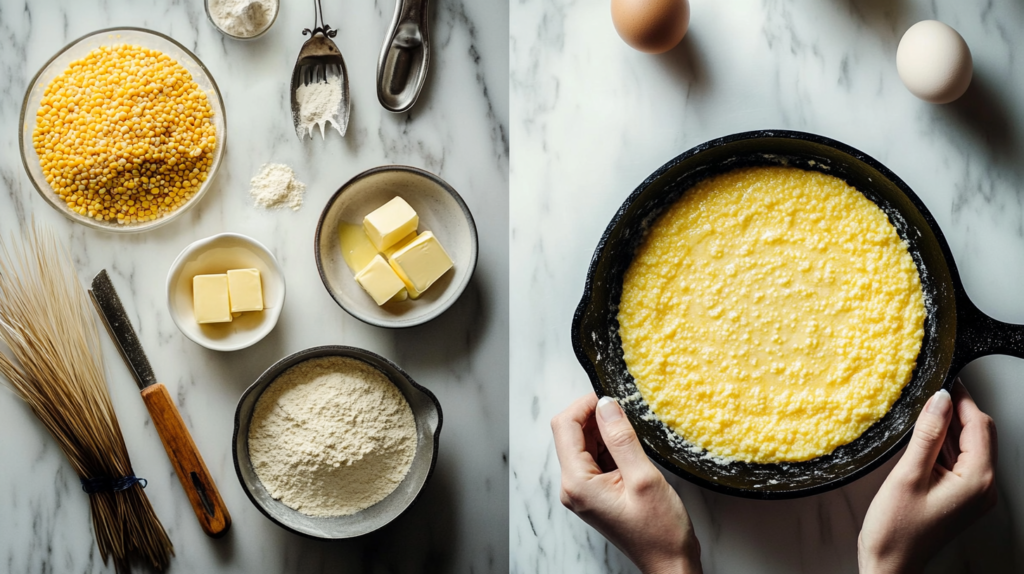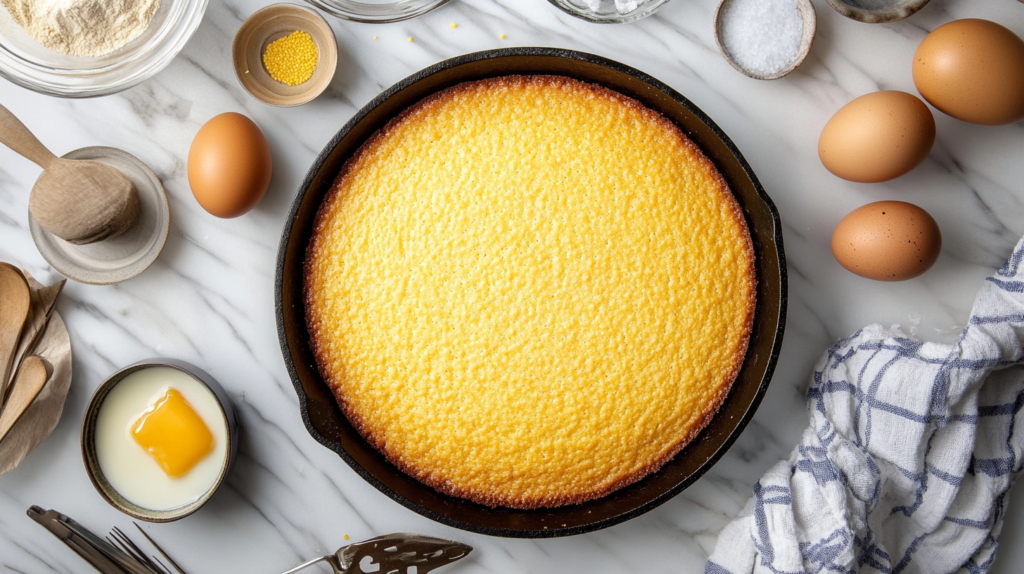Nothing says comfort food quite like a warm, golden slice of Southern cornbread. It’s not just a dish; it’s an experience steeped in tradition, flavor, and love. Whether you’re planning a hearty family dinner, a backyard barbecue, or simply craving something delicious, Southern cornbread is the perfect companion. But what makes it so special? Let’s dive deep into the world of Southern cornbread and discover the secrets to crafting this iconic dish at home.
Table of contents
- Introduction to Southern Cornbread
- Key Ingredients for Southern Cornbread
- Step-by-Step Southern Cornbread Recipe
- Common Problems and Solutions in Making Southern Cornbread
- Variations of Southern Cornbread
- Serving Suggestions for Southern Cornbread
- Frequently Asked Questions About Southern Cornbread
- You May Also Like These Southern & Comfort Food Favorites
- Conclusion: Perfecting Your Southern Cornbread
Introduction to Southern Cornbread
What Makes Southern Cornbread Unique?
Have you ever bitten into a piece of cornbread and felt like you were transported straight to the heart of the South? That’s because Southern cornbread is in a league of its own. Unlike its sweeter Northern counterpart, Southern cornbread is all about savoriness. It’s dense yet crumbly, rich in corn flavor, and pairs beautifully with just about anything — from a bowl of chili to a plate of fried chicken.
One of the main differences lies in its simplicity. Southern cornbread relies on a few basic ingredients, but the way they come together creates magic. No sugar, no fuss — just pure, honest flavor.
A Brief History of Southern Cornbread
Cornbread has been a staple in Southern cuisine for centuries. Its origins can be traced back to Native American tribes who introduced early settlers to cornmeal. Over time, the recipe evolved, incorporating influences from African, European, and Southern cultures. It became a symbol of resourcefulness, using readily available ingredients to create something nourishing and delicious.
During the Civil War, cornbread was a lifesaver for many families. It was inexpensive, filling, and versatile. Today, it’s a beloved dish that carries the rich history and traditions of the South.
“Southern cornbread isn’t just food; it’s a connection to generations of cooks who poured their hearts into every crumb.”
Key Ingredients for Southern Cornbread
Choosing the Right Cornmeal
The star of the show is undoubtedly the cornmeal. But not just any cornmeal will do! For authentic Southern cornbread, always opt for stone-ground cornmeal. It’s coarser and retains more of the natural oils and flavors of the corn, giving your cornbread that distinctively rich taste and texture.
Should you go for yellow or white cornmeal? It’s all about preference. Yellow cornmeal has a slightly sweeter, nuttier flavor, while white cornmeal offers a milder taste. Either way, make sure it’s fresh — stale cornmeal can ruin the whole experience.
The Role of Buttermilk in Cornbread
If cornmeal is the hero, buttermilk is the trusty sidekick. It adds a tangy richness that elevates the dish and helps achieve that moist yet crumbly texture. The acidity in buttermilk reacts with the baking soda, creating a lightness that balances the cornbread’s density. Can’t find buttermilk? No worries — a splash of vinegar or lemon juice in regular milk works as a substitute.
Traditional vs. Modern Additions
Purists will tell you that classic Southern cornbread doesn’t need anything extra. However, modern twists are becoming increasingly popular. From shredded cheese to diced jalapeños, these additions can add a new layer of flavor and personality to your cornbread. Still, it’s important not to overshadow the main star — the cornmeal.
Step-by-Step Southern Cornbread Recipe

Preparation: Essential Tools and Setup
Before you even think about mixing ingredients, let’s talk tools. A cast-iron skillet is non-negotiable for authentic Southern cornbread. Why? Because it creates that crispy, golden crust that’s impossible to achieve with other cookware. Preheat your skillet in the oven as you prepare the batter. Trust me, this step is the secret to cornbread perfection. ✨
Mixing the Batter: Tips for the Best Texture
Making the batter is where the magic happens. Combine your dry ingredients (cornmeal, a pinch of salt, baking soda, and maybe a bit of flour) in one bowl and your wet ingredients (buttermilk, eggs, and melted butter) in another. Slowly incorporate the wet into the dry, mixing just until combined. Overmixing? That’s a no-go — it’ll make your cornbread tough.
Baking Perfect Cornbread: Time and Temperature Guide
Pour the batter into your hot, greased skillet and listen to that satisfying sizzle — it’s the sound of a beautiful crust forming. Bake at 400°F (200°C) for 20-25 minutes, or until the top is golden and a toothpick comes out clean. Let it cool slightly before slicing, and voila! You’ve got yourself a pan of irresistible Southern cornbread.
“A well-made cornbread is like a warm hug from the South — comforting, delicious, and unforgettable.” 🌽
Common Problems and Solutions in Making Southern Cornbread
Why Does My Cornbread Turn Out Dry?
Dry cornbread is a common woe, but don’t worry — it’s fixable. The main culprits are either overbaking or using the wrong proportions of ingredients. If your cornbread tends to dry out, try reducing the baking time slightly or adding a touch more buttermilk or melted butter to the batter.
Another trick? Keep an eye on your oven. Ovens can vary, and sometimes the temperature displayed isn’t accurate. Using an oven thermometer can make a world of difference.
How to Fix Dense or Gummy Cornbread
Nobody wants dense or gummy cornbread — it should be light yet sturdy. If your cornbread comes out this way, it’s likely due to overmixing the batter or adding too much liquid. The solution? Mix just until the ingredients are combined and be mindful of your measurements.
Additionally, ensure your baking soda and baking powder are fresh. Expired leavening agents can lead to flat, gummy results.
Troubleshooting Uneven Cooking and Burning
Is your cornbread burnt on the edges but raw in the middle? That’s usually a sign of uneven heat. To fix this, make sure your skillet is preheated evenly before adding the batter. Also, consider baking the cornbread on a middle rack to ensure consistent cooking.
If you’re still having trouble, you might want to lower the oven temperature slightly and bake for a few extra minutes. Patience is key to achieving that perfectly cooked cornbread.
Variations of Southern Cornbread
Sweet vs. Savory Cornbread Debate
One of the great debates in cornbread history: sweet or savory? Traditional Southern cornbread leans savory, but that doesn’t mean you can’t enjoy a sweet version. For a slightly sweet twist, add a tablespoon or two of sugar or honey to the batter. Just remember, this moves the dish closer to the Northern style.
For those who love savory, amp up the flavor with a sprinkle of grated cheese or a dash of cayenne pepper. Adding chopped herbs like rosemary or thyme can also elevate the dish.
Add-Ins: Jalapeños, Cheese, and More (H3)
Want to take your cornbread to the next level? Add-ins are the way to go. Diced jalapeños add a spicy kick, while shredded cheddar cheese brings richness. You can also fold in ingredients like crumbled bacon, green onions, or even roasted corn kernels for added texture and flavor.
Experiment with combinations to find your perfect match. Just be careful not to overload the batter, as too many add-ins can affect the texture and baking time.
Serving Suggestions for Southern Cornbread
Classic Pairings: Dishes That Complement Cornbread
Southern cornbread is versatile enough to pair with almost any meal. Serve it alongside a steaming bowl of chili or a hearty stew. It’s also a perfect match for fried chicken, barbecue ribs, or collard greens. For breakfast, enjoy it with a pat of butter and a drizzle of honey.
Innovative Ideas for Serving Leftover Cornbread
Got leftovers? Don’t let them go to waste! Use crumbled cornbread to make a savory stuffing for poultry or a base for cornbread salad. You can even turn it into croutons by toasting small cubes in the oven. Leftover cornbread also makes an excellent topping for casseroles or as a layer in a Southern-style trifle.
“Cornbread is more than a side dish; it’s a canvas for creativity.”

Frequently Asked Questions About Southern Cornbread
1. What’s the difference between Southern and Northern cornbread?
Southern cornbread is typically savory, made without sugar, and often cooked in a cast-iron skillet for a crispy crust. Northern cornbread is usually sweeter and more cake-like in texture.
2. Can I use all-purpose flour instead of cornmeal?
Cornmeal is essential to cornbread—it gives it its distinct texture and flavor. You can use a blend of cornmeal and flour, but you can’t substitute flour entirely.
3. How do I make my cornbread more moist?
Use buttermilk and don’t overbake. Adding a touch of melted butter or a spoonful of sour cream to the batter can also help retain moisture.
4. What if I don’t have a cast-iron skillet?
A baking dish or oven-safe pan will work, but it won’t create the same crispy crust. Try preheating the baking dish to mimic the effect.
5. Can I freeze cornbread?
Yes! Let it cool completely, wrap it tightly in foil or plastic wrap, and store it in a freezer-safe bag for up to 3 months. Reheat in the oven for best texture.
6. Is Southern cornbread gluten-free?
Traditional cornbread recipes that use only cornmeal (no flour) can be gluten-free—just make sure your cornmeal is certified gluten-free.
7. How do I reheat leftover cornbread?
Wrap it in foil and reheat in a 350°F (175°C) oven for about 10–15 minutes. For individual slices, you can also use a toaster oven or microwave for convenience.
8. Can I make cornbread without eggs?
Yes. Try using a flaxseed or chia egg (1 tbsp ground flax/chia + 2.5 tbsp water) as a substitute. The texture may vary slightly, but it works in a pinch.
You May Also Like These Southern & Comfort Food Favorites
If this Southern Cornbread Recipe hit the spot, we’ve got more classic dishes you’ll want to try next. From soul-warming sides to savory mains and everything in between, these recipes bring comfort and flavor to every table:
- Pair your cornbread with the perfect main like this Boneless Beef Ribs Recipe – A Perfectly Tender and Flavorful Dish
- Make it a full Southern spread with Chicken Dressing Recipe – An Old-Fashioned Favorite Done Right
- Craving a classic combo? Don’t miss the Campbell’s Green Bean Casserole Recipe – A Classic and Comforting Side Dish
- Add some color and nutrition with this Purple Sweet Potato Recipe – Delicious and Nutritious
- Keep it traditional with this cozy Meatloaf Recipe (Lipton Onion Soup) – The Ultimate Comfort Food
- Want something rich and creamy on the side? Check out the Cheesy Rice Recipe – The Ultimate Guide to Creamy and Flavorful Rice Dishes
- Sweeten your table with this Banana Cream Pudding – A Classic Dessert with a Creamy Twist
- Prefer bold flavors? Add some spice with the Bang Bang Chicken Recipe – The Ultimate Guide to Making the Perfect Dish
- Looking for a hearty Southern-style chili? Don’t miss this Brisket Chili Recipe – A Hearty and Flavorful Comfort Food
- Or go lighter with bold flavor in the Chick-fil-A Kale Salad Recipe – A Delicious Copycat You Can Make at Home
- Want to start your mornings Southern-style? Explore these Chicken Breakfast Recipes – Start Your Day Right
Please check out other recipes on the site for more soul-satisfying Southern cooking and comforting homemade dishes.
Conclusion: Perfecting Your Southern Cornbread
Final Tips for Success
Mastering Southern cornbread takes practice, but the results are worth it. Remember to use fresh, quality ingredients, and don’t skip preheating your skillet. Keep an eye on the oven, and don’t be afraid to get creative with add-ins and variations.
Embracing the Art of Southern Cornbread
Southern cornbread isn’t just a recipe; it’s a tradition passed down through generations. Whether you stick to the classic recipe or put your own spin on it, the joy of making and sharing cornbread is what truly matters. It’s about creating a dish that brings comfort and satisfaction, not just to you, but to everyone gathered around your table.
As you hone your skills and adapt the recipe to your taste, you’ll find that Southern cornbread becomes more than a meal — it’s a reflection of your love for cooking and sharing. From its humble beginnings to your modern kitchen, this dish connects us to the past while allowing us to craft something uniquely our own.
So, grab your skillet, gather your ingredients, and let the aroma of freshly baked Southern cornbread fill your home. Whether you’re pairing it with a Southern feast or simply enjoying it with a dollop of butter, this timeless recipe is sure to delight. 🌽✨

